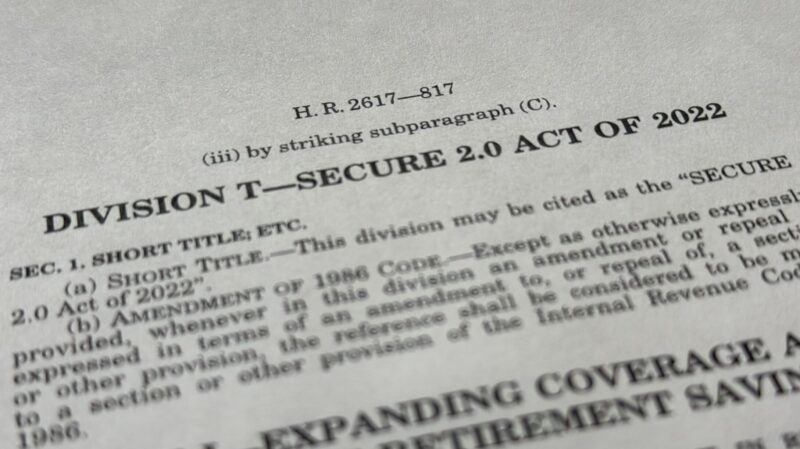In late December, Congress passed a $1.7 trillion spending bill to keep the government funded through September. Included in that bill, now signed into law by President Biden, was a package of retirement-related reforms collectively known as the SECURE 2.0 Act.
SECURE 2.0 builds on the original SECURE Act from 2019, which aimed to improve access to retirement savings for all Americans.
There are nearly 100 provisions in SECURE 2.0. While most of them aren’t particular to public defined benefit plans like Colorado PERA, many of them could affect public sector workers and retirees who have money saved in a defined contribution account like a 401(k) or 457 plan.
Here are some of the major provisions included in the legislation and what they mean.
Automatic enrollment in 401(k) plans
One of the biggest changes resulting from SECURE 2.0 will be automatically enrolling workers in their employer’s 401(k) plan starting in 2025. Unless they opt out, eligible employees will automatically contribute at least 3 percent of each paycheck to their retirement account, and that amount will increase by 1 percent each year until it reaches at least 10 percent (but not more than 15 percent). The mandatory 401(k) auto-enrollment provision will not apply to government plans like Colorado PERA.
Student loan matching on retirement accounts
This provision is aimed at people who aren’t saving for retirement because they’re paying off student loans and can’t afford both. Beginning in 2024, employers will be allowed to match a worker’s student loan payments and deposit that money into their 401(k) or 457 plan account.
Emergency savings accounts
Many Americans lack a dedicated savings account for emergency expenses and often end up tapping into their retirement savings to pay for unexpected costs. Under this provision, employers will be able (but not required) to automatically enroll workers in an emergency savings plan, with employees contributing no more than 3 percent of their salary on a Roth basis. The first four withdrawals from the account each year will be exempt from any fees or charges solely on the basis of such withdrawals.
Changes to required minimum distributions (RMDs)
Under current law, retirees are required to start taking withdrawals (required minimum distributions, or RMDs) from retirement accounts like 401(k)s when they reach a certain age. The previous SECURE Act raised that age to 72 in 2019. SECURE 2.0 raises the age to 73 as of Jan. 1, 2023 (retirees who turned 72 in 2022 and already began taking RMDs will need to continue taking their RMDs). The RMD age will then rise to 75 in 2033. SECURE 2.0 also reduces the penalty for failing to take RMDs from 50 percent to 25 percent.
New allowable distributions
Several provisions of SECURE 2.0 lay out new circumstances under which a person can withdraw money from their retirement account(s) before they’re retired without facing a penalty. The new rules allow for penalty-free withdrawals for personal or family emergencies (one distribution up to $1,000 per year), in domestic abuse cases (the lesser of $10,000, indexed for inflation, or 50 percent of the participant’s account), to pay for long-term care insurance (up to $2,500 per year) and for terminally ill patients.
Retirement account lost-and-found
For workers who have held multiple jobs throughout their careers and left behind retirement accounts, it can be a challenge to find and claim those old accounts. It can be similarly difficult for plan administrators to find account holders who may have moved or changed names. This provision creates a nationwide database of retirement plans under the Department of Labor, allowing account holders to more easily find the contact information for plan administrators and claim their old accounts.
Click here for a more detailed section-by-section explanation of each of the provisions in SECURE 2.0.
Defined benefitAlso known as a pension, this is a type of pooled retirement plan in which the plan promises to pay a lifetime benefit to the employee at retirement. The plan manages investments on behalf of members, and the retirement benefit is based on factors such as age at retirement, years of employment and salary history.Defined contributionA type of individual retirement plan in which an employee saves a portion of each paycheck (along with a potential employer match) and invests that money. The employee’s retirement benefit is based on their account balance at retirement. A 401(k) is a type of defined contribution plan.





Still nothing on getting my full Social Security benefit ?
I would love to see something happen, too.
Agreed, the WEP is absurdly arbitrary, there’s no fair or rational reason for it’s existence. Why isn’t PERA hammering away at that day & night? All they ever say about it is that it’s a federal matter which they have no influence over, yet they frequently involve themselves in other federal legislation. It’s a very porous excuse which doesn’t hold water. Have tried for 15+ years to get them to engage in a meaningful conversation about this obvious injustice… it’s like talking to a rock.
Am also interested in what is being done to eliminate the Windfall Provision.
Sad for those of us who worked hard and were Penalized with WEP (Windfall Elimination Provision). Please give us back our money.
Hello. Pera is great. ButLate last year I brought this up the government should delete the Windfall Act to Hickenlooper & Bennett. Their office responded with a roundabout letter and frankly did not address it. I was not surprised. I encourage more people to get after them. This Windfall was passed in the early mid 1980s. I was stationed in some far-off remote place in SE Asia. Totally unaware of what was going on politically. I did not retire from the military. I contacted SSA and asked how much money they are keeping from me, they never responded. I believe it is around $5K. This could help my family like it could so many others. The government could give us a tax break at least. We are not 6 figure income earners and with this inflation, it would come in handy. Afterall, we worked for this money and earned it. They just keep our money. This seems illegal to me.
It does seem like it, at least discrimination for those of us that have served. I wonder if an attorney would have what we need to file a class action suit?
In 30 years I have never known PERA to do anything that benefits the employee!!! Looks like greed prevails and things will never change………
How do I access the nationwide database of retirement plans under the Department of Labor to check for lost retirement accounts?
Hi Ramona, SECURE 2.0 just passed last month, so the database hasn’t been set up yet. The bill states that the database should be created no later than two years after the bill was enacted.
Why is it PERA ON THE ISSUES has no comment or replies on the WEP issue?
Hi Kathy, we regularly monitor on and report updates on federal legislative activity related to the WEP and GPO. We most recently shared an update in September (https://peraontheissues.com/news-you-should-know-house-committee-takes-action-on-wep-gpo-bill/) but there hasn’t been any action since. We’ll continue to monitor and share any updates if the new Congress takes any action. While PERA does not have any control over federal law, we do engage with Colorado’s congressional delegation to educate them about the effects WEP/GPO have on our members and retirees. We encourage you to contact your representatives in Congress as well.
People want you to be proactive not reactive to eliminating gpo and wep!
For each state that you worked in, check the state’s unclaimed funds.
You might also check for potential unclaimed funds in the state where your employer was headquartered if different from where you worked. That might be improper for them to have not put it in the state where you worked, but I believe that it is a common error by employers.
Does anyone know who we can contact to find out how we go about getting a little bigger cost of living like everyone else? Every year I get less money because of insurance going up more than the tiny cost of living I get. Also anyone have input on PERAcare Medicare which I qualify for in march or is getting out of PERAcare all together the better way to go. Please help because no one ever reply’s back or gives me any info. Thank you. Get rid of wep
Kim. I recently chose the PERA MA #1 plan. So far it actually seems to be better than the pre Medicare insurance. I’ve had all positive experiences, and it’s very reasonable. Not such a good deal for a partner though. Also there are rules for changing Medicare supplemental plans later on if you don’t like the Pera MA plans, but since this is a retirement organization you can change back to an outside Pera insurance without penalty. One time I think. Be sure to check with a qualified broker before making such decisions so you know exactly what the repercussions may be. Hope this helps.
What CHARL+HILL said!
The MA1 cost is low for a single person depending on your tests of service.
Hi Kim, we have a lot of information online about turning 65 and enrolling in PERACare, and we also offer a free webinar to help answer any questions you may have. You’ll find all of that information here: https://www.copera.org/turning-65-planning-for-medicare. Also feel free to call our Customer Service line at 1-800-759-7372 and we can help you one-on-one.
Our family enjoyed Kaiser health insurance via Pera during my working years. Now retired My husband and I individually contract directly with Kaiser advantage plan. It is a zero cost medical and dental program. Coverage is very similar to the $ PERA retirement plan.
I think you should check into other plans. PERA medical stuff has always been bad. We got out when we got on medicare.
The very large issue that all PERA recipients are or should be thinking about is inflation. It has dramatically affected all of us. Social Security responded by significantly increasing monthly Social Security payments, but PERA has done nothing to address inflation and has ignored the topic. I know money doesn’t grow on trees and this would be a difficult issue to solve, but at least it should be acknowledged.
Yes, we’re capped at 2 percent but we didn’t even receive that!
HB23-1016 … Inflation Relief For PERA Retirees???
HB23-1016 proposes a refundable tax credit to some PERA retirees for inflation relief. It’s limited to $700 a year, for two years, and leaves a lot to be desired, but it’s better than nothing. “Better than nothing HB23-1016,” purports to address the miserly PERA benefit increases imposed by 2018’s SB-200, which eliminated increases for a couple of years and scrapped the previous COLA (that was capped at 2%). Presently, the annual increase is 1%; but even that is conditional on long term fund solvency, not inflation, so there is no COLA; and the current non-COLA can go to zero again. Many government workers retired relying on COLA-like increases, that were tacitly implied with PERA’s traditional Defined Benefit (DB) plans and were customary to offset lower public sector salaries. It’s disturbing that PERA benefits for retirees who aren’t (or historically weren’t) considered low-income, have eroded so much in a dozen years since annual increases were eliminated (for three years), capped at 2% (for six years), and averaged out to 1.17% (over the last three years)! Unfortunately, PERA retirees eligible for any of the $700; might not be the neediest, as means-testing is different from tax policy; and tax policy would neither target relief to those who have lost the most in reduced increases nor help households with the lowest of incomes, or the most needy.
Furthermore, not all PERA retirees will benefit from HB23-1016, as it only applies to full time Colorado residents, 65* years of age, or older, who file Colorado tax returns (for a decreasing credit as taxable income increases). It seems possible the tax credit could be claimed by DEFINED CONTRIBUTION (DC) plans participants, who take a 401(k) distribution? Although I’m sure many DC plan participants are affected by inflation, that’s an inherent disadvantage of a DC plan, but PERA’s DB plan retirees are the ones who lost increases under SB18-200 (SB10-001 too), so only DB plan participants should be eligible for the tax credit! Additionally, some retirees with other tax deductions or credits or who combine a spouse’s income in the same household (but files separately) could be well off financially and still obtain the tax credit.
To date there’s no estimate of what HB23-1016 may cost in lost tax revenues, but budgetary limits imposed on lawmakers by TABOR (and circumventing TABOR by raiding state pension funds) is largely what prevents retirees from having a meaningful COLA. Foregoing tax revenue because it would be subject to TABOR, is one way to provide inflation relief to some through tax credits instead of as a budgetary outlay; but tax policy is a blunt and indiscriminate instrument; and in this case seems to be used to avoid TABOR while still pandering to a large group of voters. Instead of foregoing tax revenues because they’d fall under TABOR, it would be more honest if lawmakers approved a meaningful COLA, or even a mediocre one, for all PERA DB plan retirees. Providing a COLA, might involve a tax increase, but one which TABOR allows without a vote of the electorate in the case of state pension obligations. Since laws creating tax cuts and credits also don’t require a vote of the electorate, this will be another way to circumvent TABOR, like calling taxes a fee or toll, along with raiding trust funds and cutting other budgeted items (services). At some point the financial smoke and mirrors will no longer fool people, but until then, the majority of PERA’s DB plan retirees will continue to suffer with or without a tax credit.
In closing, in the long run HB23-1016 is bad tax policy that will not to help most PERA retirees, or those who need assistance, regardless of inflation; but some legislators have at least recognized the impact inflation is having on the retirees who have suffered due to earlier legislation eliminating PERA DB plan’s traditional COLAs; and perhaps this will serve as starting point to summon up the political courage and leadership that is really needed to address the broken promises made to PERA DB plan members.
____________________________________________
Footnote* – As amended 30JAN2023 in the House Finance Committee Hearing, the age limit was increased to 65 from 55, except for retired state troopers.
Yes, does anyone know what, if anything, is happening with the bill(s) that were drafted to eliminate the WEP and GPO? Are they just going to sit there while they waste their time and our tax dollars fighting each other instead of working for us? I have written our senators and my representatives on numerous occasions, and both of our presidents, and receive runaround responses that don’t even mention it. Hickenlooper was the worst, not addressing the issue and sending me a solicitation for campaign contributions after he had already won the election! Talk about a swamp creature!
I agree with you, Walter R, it seems illegal, at the very least discrimination against those of us who have both served our states and worked in the private sector. I wish we could find an attorney willing to take on a class action lawsuit for us all. Anyone know of an attorney willing to be bold enough to right these wrongs?
Thanks for letting me vent, all.
Hi Bonnie, we haven’t seen any legislative action on the WEP/GPO since the fall (https://peraontheissues.com/news-you-should-know-house-committee-takes-action-on-wep-gpo-bill/), but we will continue to monitor and will be sure to post any updates if and when the new Congress introduces any new legislation.
What is “Disability Retirement ” versus “Retirement” under PERA? How are benefits under each treated, including taxation? Concerning divorce, in particular, may Disability Retirement benefits be split and distributed to an ex-spouse? The PERA administrators did this to me, giving away over $40,000.00 of my Disability benefits before I reached retirement age, money necessary to pay for medical expenses. I understood that, according to PERA rules, Retirement benefits do not vest until you reach retirement age. It seems that PERA may not interpret policy and legislation correctly.
Hi Che, sorry to hear about the difficulty you’re having with your PERA benefits. If you call our Customer Service line at 1-800-759-7372, we’d be happy to pull up your account and answer any questions you may have.